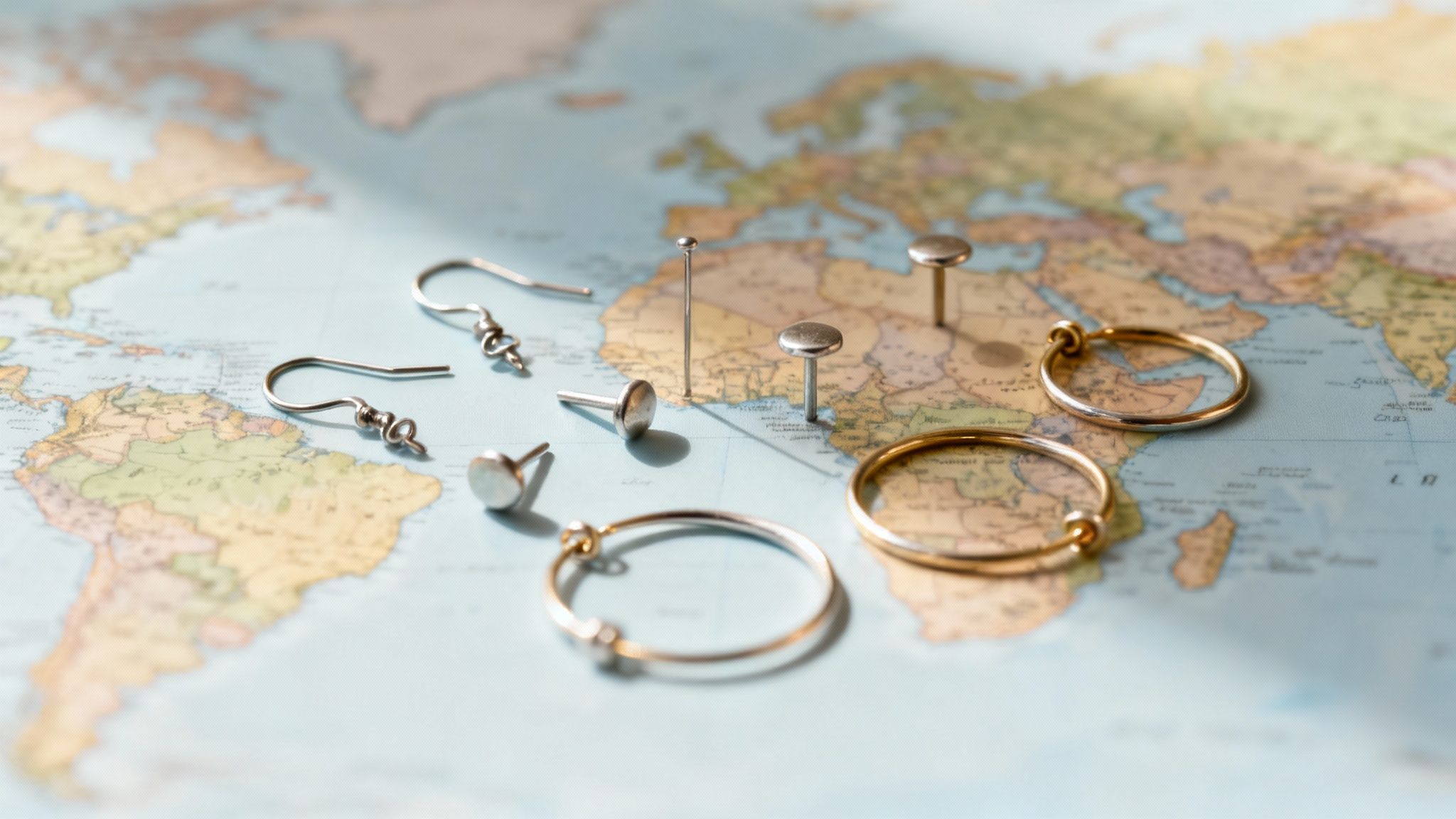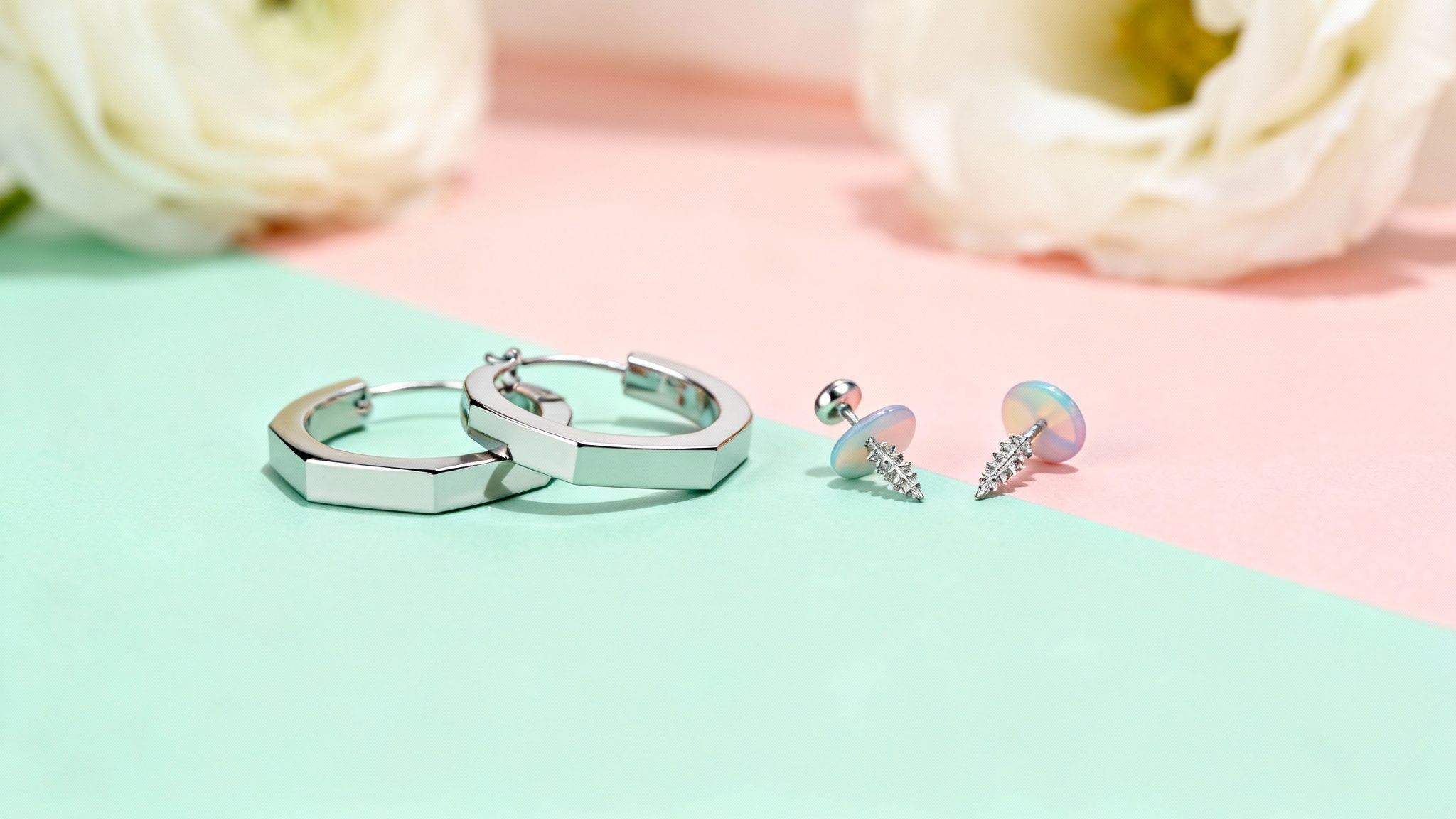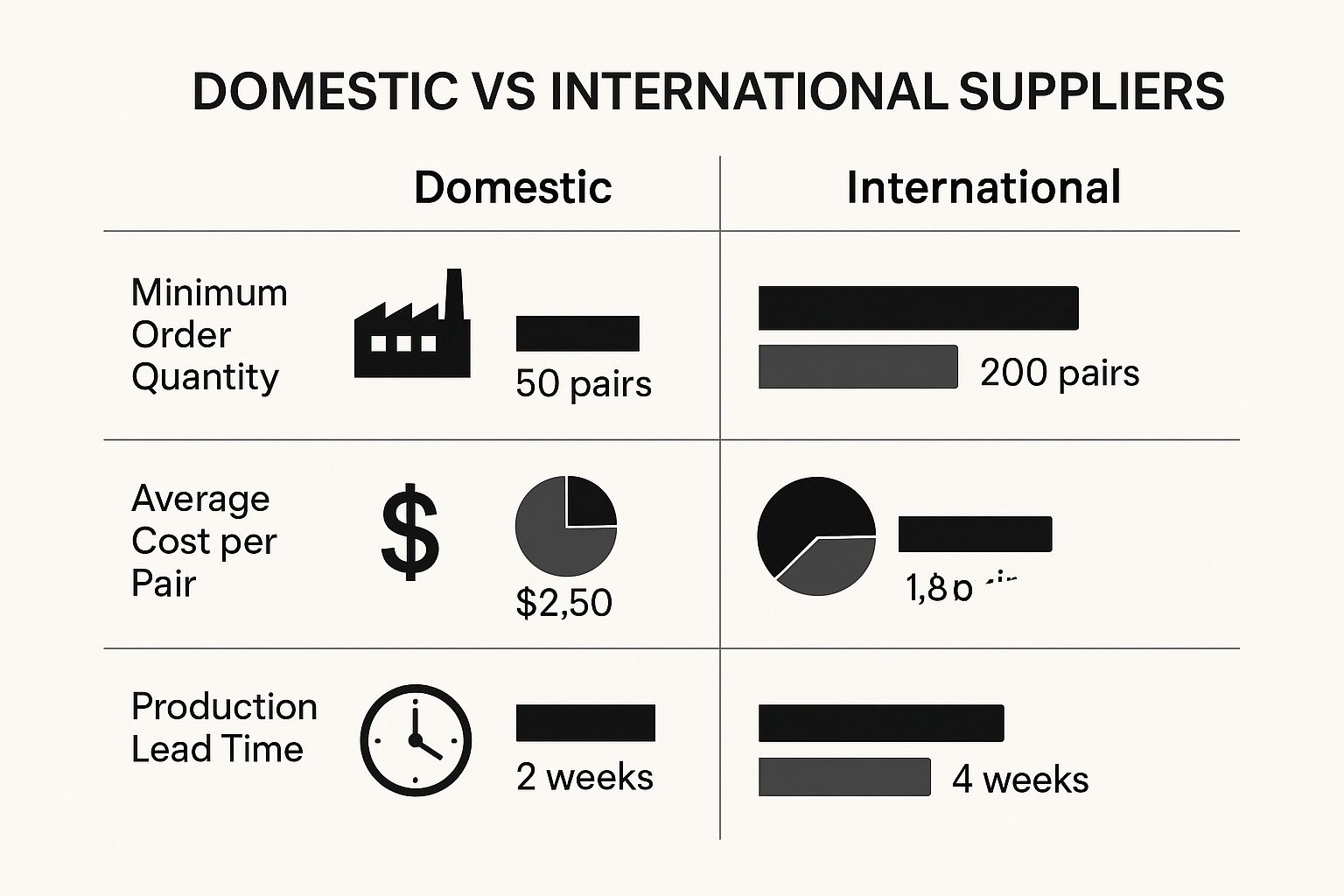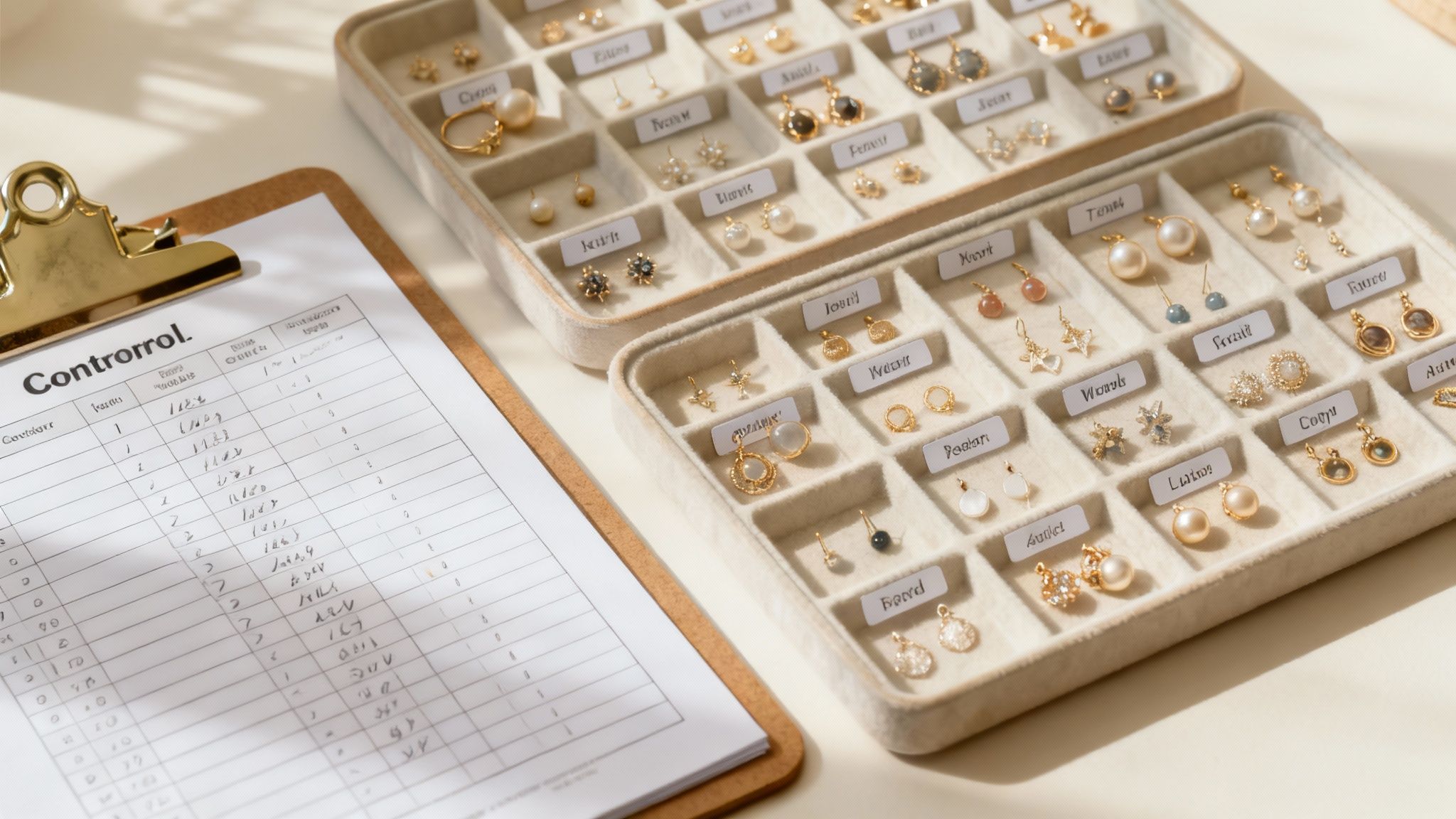Arthur Lynch | Sun Oct 12 2025
Your Guide to Earring Supply Wholesale Success
Finding the right wholesale earring supplier isn't just a transaction—it's a critical partnership for your jewelry business. This guide offers actionable insights into navigating a dynamic global market, helping you align your sourcing strategy with key fashion trends, fluctuating material costs, and the unique strengths of different manufacturing regions.
Understanding the Wholesale Earring Supply Market

Before placing an order, it's essential to understand the landscape. The wholesale earring supply world is a vast, interconnected network of manufacturers, distributors, and designers, all influenced by global economics and the rapid pace of fashion. Mastering these dynamics is your first competitive advantage.
The jewelry industry is booming. The market was valued at an estimated $367 billion in 2024 and is projected to hit nearly $578 billion by 2033. This growth is driven by rising disposable incomes and a constant consumer desire for new, stylish accessories. You can find out more about these global jewelry market projections and see how they might shape your sourcing strategy.
Mapping Global and Regional Trends
Different regions excel at producing specific components and often set their own unique style trends. Understanding this geography is crucial for sourcing supplies your customers will actually buy.
-
Asia-Pacific Dominance: This region, led by China, India, and Japan, accounts for over 60% of the global jewelry market. It's a powerhouse for cost-effective, high-volume manufacturing of everything from basic earring hooks and posts to intricate charms. Actionable Insight: Look to suppliers in South Korea for trendy, minimalist designs like threader earrings and delicate huggie hoops, and to China for mass-produced components like enamel charms and acrylic shapes.
-
European Craftsmanship: Italy is synonymous with quality chains, clasps, and precious metal findings. Sourcing from Europe typically costs more, but the superior finish and luxury feel can significantly elevate your brand's perceived value. Actionable Insight: Source sterling silver or gold vermeil components from Italy to create a premium "demi-fine" collection that commands a higher price point.
-
North American Innovation: The U.S. and Canada host a vibrant community of independent designers and niche suppliers. This is the ideal place to find unique, ethically sourced gemstones and specialized, handcrafted components that differentiate your brand. Actionable Insight: Seek out small-batch suppliers in North America for recycled metals or unique cast charms to build a collection with a strong story of sustainability and local craftsmanship.
I see so many new designers make the mistake of sourcing based only on the lowest price per piece. A smart business owner balances cost with what's actually selling. For example, sourcing minimalist gold-plated hoops from a Korean supplier for a North American audience perfectly aligns your product with a hot trend. That gives you a much better chance of selling out than just buying the cheapest components you can find.
Having this global perspective helps you make smarter choices. Are you building a brand around affordable, fast-fashion pieces, or are you focused on creating high-end, artisanal earrings? Your answer will point you to the right place on the map to find your ideal wholesale partners.
How to Spot and Source Trending Earring Styles

Finding the right earring supply wholesale isn’t about buying what you personally love. It's about anticipating what your customers will be obsessed with next. Staying ahead of the curve requires digging into real, actionable trend intelligence. Let’s break down how to spot what’s hot and where to find the components to build those must-have styles.
The earring market was valued at around $25 billion in 2025 and is on track to hit nearly $42 billion by 2033. This growth is driven by a global appetite for fresh designs. One minute it's classic hoops, the next it's bold, artistic statement pieces.
Decoding Global and Regional Tastes
Fashion isn't a one-size-fits-all game. A bestseller in one region might not sell elsewhere. Understanding these nuances is the secret to smarter sourcing.
In Western markets like North America and Europe, the current mood is bold and sculptural. Think oversized gold-plated hoops ("Bottega-inspired" teardrops), mixed-metal designs, and vintage-inspired statement pieces with large baroque pearls. Actionable Insight: When searching wholesale sites, use keywords like "chunky gold hoops," "sculptural posts," and "baroque pearl charms" to find relevant components.
Meanwhile, many Asian markets, especially in Korea and Japan, favor delicate and asymmetrical designs. Trends there lean toward minimalist chain threaders, mismatched studs (e.g., a star on one ear, a moon on the other), and tiny, intricate charms. Actionable Insight: To source for this aesthetic, search for "dainty chain findings," "micro-pave studs," and "small-scale CZ charms."
Sourcing successfully means connecting the dots between a macro trend and the raw materials you need. See 'dopamine dressing' taking over with its bright, playful energy? That's your cue to start looking for suppliers with vibrant enamel charms, colorful resin components, and fun acrylic shapes. Don't wait for finished products to hit the market—source the supplies to create them yourself.
Tapping into Digital Trend Ecosystems
The fastest-moving trends now emerge from social media. Platforms like TikTok and Instagram have become real-time focus groups.
-
TikTok Micro-Trends: Jump on TikTok and search hashtags like #jewelrymaking, #earringstack, and #coquettejewelry. You’ll see exactly what creators are making and what's going viral. If you notice a sudden flood of videos featuring bow-themed earrings, that’s a direct signal to start sourcing ribbon-shaped charms and pearl components immediately.
-
Instagram Influencers: Follow a mix of jewelry designers, fashion influencers, and boutique owners. Their posts are often a sneak peek of emerging styles. Pay close attention to the details. Are they layering specific types of hoops? Mixing metals in a new way? This visual data is gold. For a closer look at what's hot right now, check out our deep dive into the top jewelry trends for 2024.
Beyond daily styles, monitor bigger industry shifts. The demand for sustainable materials—like recycled metals and lab-grown stones—is growing. At the same time, gender-neutral designs that appeal to a wider audience are becoming a core part of modern collections. Building these values into your sourcing strategy isn't just good for business; it strengthens your brand's relevance.
Finding and Vetting Wholesale Earring Suppliers
Choosing the right partner for your earring supply wholesale needs is a make-or-break decision. A fantastic supplier means quality components arrive on time. A bad one leads to production nightmares and angry customers. This isn't about a quick Google search; it's about finding a true partner for your brand.
The fashion jewelry components market was valued at around $40.2 billion in 2024 and is projected to skyrocket to $65.8 billion by 2035. That’s a huge opportunity, but it also means there are thousands of suppliers—and not all are created equal.
Where to Start: B2B Marketplaces and Trade Shows
The hunt for a great supplier usually begins online, but you need to know where to look.
-
Global Sourcing Giants: Sites like Alibaba connect you directly with manufacturers, mostly in Asia. You'll find rock-bottom prices, but the trade-off is high Minimum Order Quantities (MOQs) and longer shipping times. Actionable Insight: This is the right move when you have a proven bestseller and are ready to order 500+ units of a single component to maximize your profit margin.
-
Curated Wholesale Hubs: Platforms like Faire are built for independent retailers. Suppliers are often pre-vetted, MOQs are lower, and products are usually finished or semi-finished. Actionable Insight: Use these platforms to test new designs with low risk or to quickly restock popular items without committing to a large inventory investment.
Don't just hide behind your screen. Jewelry and fashion trade shows are treasure troves for discovering suppliers with unique, top-notch components who may not have a large online presence. Nothing beats holding a finding in your hand and talking directly with the people who make it.
The Big Decision: Domestic vs. International Suppliers
Should you source locally or globally? It’s a balancing act between cost, speed, and control.

International sourcing almost always wins on price, but that savings comes with higher MOQs and longer lead times. Actionable Insight: A hybrid approach is often best. Source your core, high-volume components (like basic hoops or chains) internationally to save on costs. Source your unique, trend-driven, or delicate components (like gemstones or custom charms) domestically for faster turnaround and better quality control.
Comparing Wholesale Supplier Types
This side-by-side look at different supplier models will help you choose the right partner for your specific needs.
| Supplier Type | Best For | Pros | Cons |
|---|---|---|---|
| Direct Manufacturer | Scaling businesses buying in high volume | Lowest per-unit cost; customization options | High MOQs; communication barriers; long lead times |
| General Wholesaler | Retailers needing a wide variety of components from one source | One-stop shopping; lower MOQs than manufacturers; faster shipping | Higher cost per unit; less control over quality; limited unique offerings |
| Specialty/Niche Supplier | Designers seeking unique or high-quality materials (e.g., precious metals) | High-quality, unique components; expert knowledge | Higher prices; smaller selection; may have limited stock |
| Dropshipper/Jobber | New businesses testing the market with zero inventory risk | No inventory management; low startup cost | Highest cost per unit; no control over stock or shipping; thin margins |
You might end up working with a mix of these suppliers as your business grows and your needs change.
How to Properly Vet a Supplier
Once you have a shortlist, it's time to do your homework. The goal is to get clear, specific answers that protect your business. For a deeper look into potential partners, you might want to check out our guide on the best wholesale jewelry suppliers.
A supplier’s willingness to answer detailed questions tells you everything you need to know. If they get dodgy about material certifications or can’t give you a straight answer on production timelines, that’s a huge red flag. A true partner is an open book because they're invested in a long-term relationship, not just a quick sale.
Actionable Insight: Create a standardized questionnaire spreadsheet to send to every potential supplier. This allows you to easily compare their MOQ, pricing, lead times, and payment terms side-by-side.
Make sure you ask these non-negotiable questions:
- What are your Minimum Order Quantities (MOQs)? Get specifics for per-style, per-color, and the total order.
- Can you provide material certifications? This is crucial for backing up claims like "nickel-free" or "hypoallergenic." Ask for the actual documents.
- What is your standard production lead time, from the moment I pay to the day it ships?
- What are your payment terms? Is it 50% upfront and 50% on completion, or something else?
- Do you offer samples? What’s the process and cost for getting them?
Placing Your First Wholesale Order with Confidence
Making that first big leap into buying earring supply wholesale can feel daunting. It’s a real investment in your business. The best way to navigate this is with a solid, step-by-step plan that protects your cash and gets you exactly what you need.
Before you place a bulk order, you absolutely must get your hands on samples. This is non-negotiable. It's the only way to truly assess the quality of the components that will represent your brand.
Inspecting Samples Like A Pro
When that sample package arrives, scrutinize every detail. A little time spent here can save you from a massive headache later.
Here's an actionable checklist for evaluating new components:
- Plating and Finish: Hold the piece under a bright light. Look for inconsistencies, scratches, or thin spots in the plating. A good finish should be smooth and even. Actionable Insight: Rub the component lightly with a soft white cloth to check if the plating flakes or transfers color.
- Post and Hook Sturdiness: Gently bend the earring posts. They should have some resistance and feel solid, not flimsy. Weak posts are a one-way ticket to customer complaints.
- Weight and Feel: Does it feel substantial or cheap? The perceived value of your finished jewelry often comes down to the weight and feel of the materials.
- Clasp and Backing Functionality: Test all moving parts. Clasps should click shut securely, and earring backs should slide onto posts snugly—not so tight you have to fight them, but not so loose they fall off.
Think of your first order as a negotiation, not just a purchase. Many suppliers are willing to discuss pricing and payment terms, especially for larger quantities. Don't be afraid to ask for a better deal—the worst they can say is no.
Crafting The Perfect Purchase Order
Once you’re happy with the quality, it's time to draft a crystal-clear purchase order (PO). A well-written PO prevents misunderstandings and is the official contract between you and your supplier.
Your PO should leave no room for interpretation. Be painstakingly detailed.
Actionable Insight: Use a spreadsheet template for your POs to ensure you never miss a critical detail. This consistency makes reordering and record-keeping much easier.
Your PO must include:
- Itemized List with SKU Numbers: List every single item with its SKU. Add a detailed description (e.g., "18k Gold-Plated Brass Hoop, 20mm") and a picture to be extra clear.
- Precise Quantities: State the exact number of units you need for each item.
- Agreed-Upon Pricing: Document the price per unit and the total cost, making sure it matches your quote.
- Material Specifications: Restate important details like "nickel-free" or "sterling silver."
- Delivery Deadlines: Specify the date you expect the order to ship and the final date you need it delivered by.
- Shipping and Payment Terms: Outline the agreed-upon shipping method and payment schedule (e.g., "50% deposit, 50% upon shipment").
This level of detail ensures there's no confusion and sets you up for a smooth partnership.
Managing Your Inventory and Quality Control

Getting confirmation for your earring supply wholesale order is a great feeling, but the work isn't over. What you do after the order is placed is just as important—it’s where you protect your investment.
This means getting a handle on international shipping and, critically, performing a rigorous quality control check the minute those boxes arrive.
International shipping can have hidden costs. You need to understand your "landed cost"—the total price to get the supplies to your door. This includes the product cost, shipping fee, customs duties, and import taxes. These fees vary by country and material, so do your homework on your country's specific tariff codes for jewelry components. A little research now can save you from a surprise bill later.
Conducting a Thorough Quality Control Inspection
Once your shipment arrives, it's time to work. Never assume a bulk order will be 100% perfect. Finding a bent earring post now is far better than getting an angry email from a customer later.
Use this actionable QC checklist:
- Count Everything: First, does the quantity match your purchase order? Count every style, color, and size.
- Check for Physical Defects: Look for scratches, dents, or signs of tarnish. Make sure earring posts are straight and firmly attached.
- Test Functionality: Open and close every single clasp. Make sure earring backs fit snugly. If you ordered charms with moving parts, test them.
- Verify Color and Finish: Pull out your approved samples and compare them side-by-side. Is the gold plating the right shade? Is the enamel work consistent across the batch? Actionable Insight: Don't just check one or two pieces from a bag. For a batch of 100, spot-check at least 10-15 pieces from different parts of the bag to get a representative sample.
A supplier's reaction to a quality issue tells you everything you need to know about them. A great partner will work with you to make it right, whether that means a partial refund, a credit on your next order, or shipping out replacements for the bad pieces.
Setting Up Your Inventory System
Good organization is your first line of defense against damage and production bottlenecks. A solid inventory system tells you what you have, where it is, and when it’s time to reorder.
Actionable Insight: Sort your new supplies into clearly labeled, sealed containers or small ziplock bags with anti-tarnish strips inside. Small, transparent bins or partitioned organizers are perfect for this.
This is also the moment to update your inventory records, whether you're using a simple spreadsheet or dedicated software. Knowing your stock levels is fundamental. If you want to get smarter about managing your supplies, check out our guide on how to use an inventory turnover ratio calculator. It offers great insights into how efficiently you're turning components into cash.
An organized system doesn't just protect your investment; it makes the entire creative process faster and less stressful.
Your Top Questions About Wholesale Earring Supplies, Answered
Juggling questions about quality, cost, trends, and logistics is a common challenge. Let's clear up some of the most frequent hurdles for jewelry designers and retailers.
What Are the Best Materials for My Earring Designs?
The "best" material depends on your brand, price point, and target customer.
For accessible, on-trend fashion jewelry, you can't go wrong with stainless steel, sterling silver, and brass. Stainless steel is extremely popular right now because it’s hypoallergenic and highly resistant to tarnish, making it a fantastic, low-maintenance choice for everyday wear.
If you're aiming for a more premium, "demi-fine" collection, your best bets are gold-filled or gold vermeil findings.
- Gold-Filled: A thick layer of gold heat-bonded to a base metal. It offers the look and durability of solid gold without the high cost, making it a perfect middle-ground option.
- Gold Vermeil: The standard for affordable luxury. It involves plating a thick layer of gold (at least 2.5 microns) over a sterling silver base.
Pro Tip: No matter which metal you choose, always, always confirm that your supplies are nickel-free and lead-free. This isn't just a quality marker—it's a massive selling point for the huge number of customers with sensitive skin.
How Do I Figure Out the True Cost of an International Order?
The price on the supplier's website is just the beginning. To protect your profit margins, you must calculate the landed cost—the final, all-in price to get supplies to your door.
The formula is: (Product Cost + Shipping) + Customs Duties + Taxes + Brokerage Fees. If you miss any piece of that puzzle, you're pricing your finished earrings based on bad data.
Actionable Insight: Before placing a large order, use an online import duty calculator for your specific country. Enter the type of goods (e.g., "jewelry findings") and the total value to get a reliable estimate of the taxes and duties you'll owe. This removes the guesswork.
What’s a Normal Minimum Order Quantity (MOQ)?
MOQs vary widely.
For a smaller brand, a reasonable MOQ is typically 50 to 200 pieces per style. Many suppliers on curated wholesale platforms cater to smaller businesses and might offer even lower minimums.
On the other hand, a large overseas factory might require an order in the thousands. Actionable Insight: Don't be afraid to negotiate. A great tactic is to ask if you can meet their overall minimum spend by combining smaller quantities of several different components. This shows you’re a serious buyer and lets you diversify your inventory without over-investing in a single component.
Ready to source with confidence? JewelryBuyDirect offers direct-from-factory pricing on over 120,000 styles with no minimum order requirements, helping you build your collection without breaking the bank. Explore our vast selection and enjoy a 15% welcome discount on your first three orders.


 to show code
to show code





















































































































































